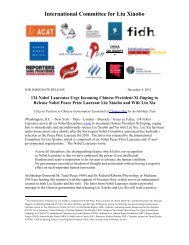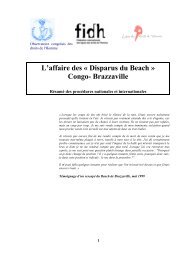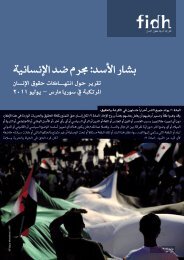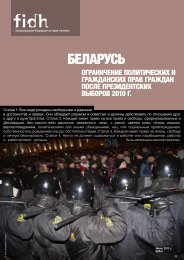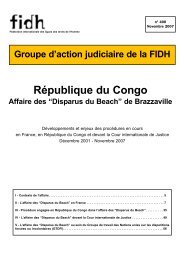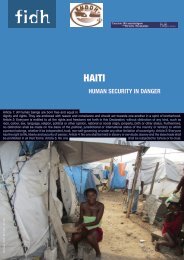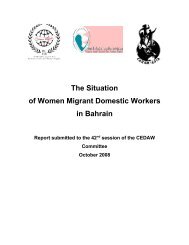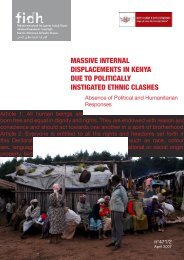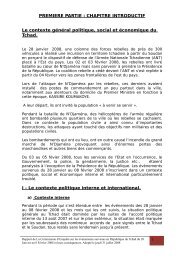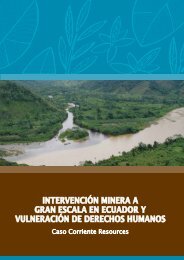KYRGYZStAN - FIDH
KYRGYZStAN - FIDH
KYRGYZStAN - FIDH
- No tags were found...
Create successful ePaper yourself
Turn your PDF publications into a flip-book with our unique Google optimized e-Paper software.
were still at large, could but reinforce the paranoia of a government panicked by the signsof its impotence. Especially as the Bakiyev supporters' capacity to harm had been clearlydemonstrated by their violent action at Djalal-Abad on May 13-14, 2010. According to thepolitical analyst Marat Kazakpaev, encountered during the mission, “the Interim governmentis afraid of the south, which it has never really controlled.” 56 When the President ofthe Interim government, Roza Otunbaeva, visits Osh, she wears a bullet-proof vest.It was of course convenient to focus on the “Bakiyevist threat”, because at the same timeit criminalised the former regime and legitimised the new one, but it did a lot to blind theauthorities to the real nature of the threat. The director of the Adilet Legal Clinic, CholponJacupova, told the members of the <strong>FIDH</strong> mission of a significant instance of how thethreats were perceived at the highest level of the State a few days before the outbreaks ofviolence in Osh. “Early in June Roza Otunbaeva invited us, Aziza (Abdirasulova), Tolekan(Ismailova) and myself to discuss the situation. She appeared very concerned at the GSNBreports on the tension in the south. But what really worried her were the activities of thepolitical opponents, the manoeuvres of the Bakiyevists, and the rumours of a new coupd’état, far more than the inter-ethnic tensions. We advised her to announce an amnesty,to launch a national reconciliation policy and to stop the despoilment and transfer ofproperty”. 57IV.3 Violence erupts in the southFrom June 10 to 14, dramatic outbreaks of inter-ethnic violence erupted in Osh and itssuburbs. Several hundred people were killed during the clashes between Kyrgyz and Uzbekcivilians. On June 10, Osh, the country's second largest city, became the theatreof anti-Uzbek pogroms. A minor incident, an ordinary scuffle between groups of youngpeople near a casino, was enough for political rivalry to turn into an inter-ethnic conflict.A large crowd of ethnic Uzbeks gathered in the in the evening of June 10, shouting anti-Kyrgyz slogans. There were several violent attacks that night against Kyrgyz civilians, andseveral buildings were put on fire. The police arrived some hours after the violence hadbegun. The ministry of the Interior Special forces then dispersed the crowd by firing in theair and with tear gas hand grenades.The violence then spread to other parts of the city. What information there was and therumours that were circulating ignited the fury of the Kyrgyz population of Osh and thesurrounding area, and thousands of them entered the city. From the morning of June 11until June 14, mobs attacked the Uzbek districts, and in some case the inhabitants foughtback. Barricades were put up. Rioters looted and set fire to Uzbek houses and shops inOsh, Djalal-Abad, Bazar-Kurgan and other southern cities, burning down whole districtsin several regions. It would appear that the rioters managed to grab the weapons of thesoldiers when they arrived.At least 371 persons (official count issued by the Kyrgyz ministry of Health on August 9,2010), and perhaps far more (up to 2 000 according to unofficial reports) were killed. 300000 Uzbeks are reported to have fled, of whom 85 000 to Uzbekistan. 49 persons are stilldeclared missing. Several thousand buildings, belonging mainly to Uzbeks, were completelydestroyed. At present thousands of people are homeless, their home having beendemolished.It is difficult to determine the exact sequence of the June events, and the real number ofvictims of the violence is not yet known. Human Rights Watch, after conducting a largenumber of interviews, has attempted to reconstitute the chronological sequence of thesetragic events 58 . A thorough and impartial enquiry is still necessary, in order to determineexactly what happened and where responsibilities lie.56. Conversation with Malat Kazakpaev, 25.06.2010.57. Interview of Cholpon Djakupova, 21.06.2010.58. Kyrgyzstan. Where is the Justice ? Interethnic Violence in Southern Kyrgyzstan and its Aftermath. Human Rights Watch, 2010. http://www.hrw.org/fr/reports/2010/08/16/where-justice-0V. THE TRAGICDESTABILISATION OF THECOUNTRYVery soon the interim government attempted to give the impression that the country hadreturned to normal. The decision to maintain the constitutional referendum on June 27,less than two weeks after the deadly events in Osh, was a case in point, illustrating thepolitical determination of the government to proceed regardless of the real tensions rifein the country. Contrary to official declarations, acts of violence have continued since theinterethnic clashes in the south. Kyrgyzstan is durably destabilised. Only political recognitionof the situation can make it possible to envisage long-term solutions.V.1 Violence continues, despite official declarations to thecontraryThe closing down of the refugee camps in Uzbekistan and the return of numerous displacedpersons may have given the impression that the situation had returned to normal.After the violent events in June, the Kyrgyz authorities tried to promote reconciliation betweenthe Uzbek and Kyrgyz communities. Roza Otunbaeva paid several visits to Osh andother cities in the south of the country.However the fact that the violent clashes stopped after a week does not mean that violencehas disappeared from the region. In the city of Osh, in particular, the situation remainsvery tense, and violent episodes occur daily. Gunfire has virtually ceased. But in aclimate in which both sides keep strictly apart from each other, and in which each sideviews the other with profound mistrust, each day brings its toll of beatings, rape, hostagetakingand assassinations. The fact that the central government is incapable of halting theviolence or bringing the authors to justice bears witness to its weakness.The member of the <strong>FIDH</strong> mission who went to Osh on June 27 recorded testimonies thatshowed that even after June 14, the official date of the end of the incidents, acts of violencewere continuing in the region. All the NGO representatives the <strong>FIDH</strong> mission metwith from June 20 to 28 confirmed that acts of violence were continuing.A man of Kyrgyz nationality told how his brother had disappeared: “On June 14, when theauthorities declared that all was calm and that the pogroms had stopped, my brother, ashopkeeper, went out with his son to see how his shop had fared. Some men then suddenlyappeared in the Tcheremuchki district, some of them carrying firearms. They struck mynephew with a rifle butt, and he fell to the ground, unconscious. They seized my brotherand took him away. I have had no news of him since.” 59According to the Alliance of Women’ Legislative Initiatives, more than 60 women wereraped in the Osh and Djalal-Abad area during the June interethnic clashes. Cases of rapehave also been recorded since the situation has become calmer. The case of TadjikhonMamadjanova illustrates the persistence of sexual violence and the threats against womenwho file a complaint. The members of Tadjikhon Mamadjanova’s family were victims ofacts of violence during the night of June 24-25, in the village of Asantchek, five kilometresfrom Osh 60 . According to their testimony, they had returned from a refugee camp that very59. Interview of a Kyrgyz inhabitant, Osh, 27.06.2010.60. Interview of the Abdulaev family, Asantchek village, 27.06.2010.24 / KYRGYZSTAN <strong>FIDH</strong> – KYRGYZSTAN / 25




